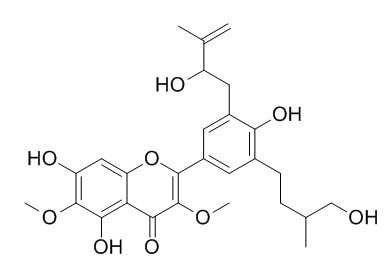Dodoviscin A
Dodoviscin A may be a new promising pigmentation-altering agent for cosmetic and therapeutic applications, it can inhibit melanin biosynthesis induced by 3-isobutyl-1-methylxanthine and PD98059.Dodoviscin A can promote adipocyte differentiation as characterized by increased triglyceride levels in 3T3L1 cells, it can enhance the accumulation of lipid droplets and induce upregulation of the expression of the adipocyte-specific genes aP2 and GLUT4.
Inquire / Order:
manager@chemfaces.com
Technical Inquiries:
service@chemfaces.com
Tel:
+86-27-84237783
Fax:
+86-27-84254680
Address:
1 Building, No. 83, CheCheng Rd., Wuhan Economic and Technological Development Zone, Wuhan, Hubei 430056, PRC
Providing storage is as stated on the product vial and the vial is kept tightly sealed, the product can be stored for up to
24 months(2-8C).
Wherever possible, you should prepare and use solutions on the same day. However, if you need to make up stock solutions in advance, we recommend that you store the solution as aliquots in tightly sealed vials at -20C. Generally, these will be useable for up to two weeks. Before use, and prior to opening the vial we recommend that you allow your product to equilibrate to room temperature for at least 1 hour.
Need more advice on solubility, usage and handling? Please email to: service@chemfaces.com
The packaging of the product may have turned upside down during transportation, resulting in the natural compounds adhering to the neck or cap of the vial. take the vial out of its packaging and gently shake to let the compounds fall to the bottom of the vial. for liquid products, centrifuge at 200-500 RPM to gather the liquid at the bottom of the vial. try to avoid loss or contamination during handling.
Antioxidants (Basel).2023, 12(2):447.
Int J Mol Sci. 2014, 15(5):8443-57
Toxicol Appl Pharmacol.2021, 427:115668.
Molecules.2022, 27(21):7514.
Front Pharmacol.2021, 12:652860.
LWT2021, 138:110397.
Int J Mol Sci.2022, 23(1):538.
Microchemical Journal2024: 196:109676.
Antioxidants (Basel).2020, 9(4):326.
Journal of Cluster Science2024, 35:635-656.
Related and Featured Products
Planta Med. 2013 Jul;79(11):933-8.
Dodoviscin a inhibits melanogenesis in mouse b16-f10 melanoma cells.[Pubmed:
23804039]
Nowadays, abnormal hyperpigmentation in human skin such as melasma, freckles, and chloasma has become a serious esthetic problem. Cutaneous depigmenting agents could be used to treat these hyperpigmentation-associated dieseases. Dodoviscin A is a natural product isolated from the aerial parts of Dodonaea viscosa.
In the present study, we evaluated the effect of Dodoviscin A on melanin production in B16-F10 melanoma cells for the first time.
METHODS AND RESULTS:
We found that Dodoviscin A inhibited melanin biosynthesis induced by 3-isobutyl-1-methylxanthine and PD98059 significantly, and there was no obvious effect on the viability of Dodoviscin A-treated B16-F10 cells. Meanwhile, Dodoviscin A could suppress the activity of mushroom tyrosinase in the cell-free assay system and also decrease 3-isobutyl-1-methylxanthine-induced tyrosinase activity and expression of mature tyrosinase protein in B16-F10 cells. Western blotting analysis showed that Dodoviscin A inhibited 3-isobutyl-1-methylxanthine and forskolin-induced phosphorylation of the cAMP response element binding protein in B16-F10 cells.
CONCLUSIONS:
These results indicate that Dodoviscin A may be a new promising pigmentation-altering agent for cosmetic and therapeutic applications.
J Nat Prod. 2012 Apr 27;75(4):699-706.
Isoprenylated flavonoid and adipogenesis-promoting constituents of Dodonaea viscosa.[Pubmed:
22512738]
METHODS AND RESULTS:
Ten new isoprenylated flavonol derivatives, Dodoviscin A, dodoviscins B
-J (1-10), and seven known compounds (11-17) were isolated from the aerial parts of Dodonaea viscosa. Compounds 1, 2, 4, 5, 7-9, 5,7,4'-trihydroxy-3',5'-bis(3-methyl-2-buten-1-yl)-3-methoxyflavone (11), 5,7,4'-trihydroxy-3',5'-bis(3-methyl-2-buten-1-yl)-3,6-dimethoxyflavone (12), 5,7,4'-trihydroxy-3'-(4-hydroxy-3-methylbutyl)-5'-(3-methyl-2-buten-1-yl)-3,6-dimethyoxyflavone (13), sakuranetin (14), and blumeatin (15) promoted adipocyte differentiation as characterized by increased triglyceride levels in 3T3L1 cells.
CONCLUSIONS:
Compounds 1, 13, and 15 also enhanced the accumulation of lipid droplets and induced upregulation of the expression of the adipocyte-specific genes aP2 and GLUT4.



